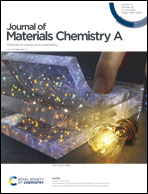Enhanced performances of lithium metal batteries by synergistic effect of low concentration bisalt electrolyte†
Abstract
Li-metal batteries (LMBs) are regarded as next generation storage devices for applications in a wide range of fields, such as electric vehicles and grid-scale energy storage. Unfortunately, their practical applications have been restricted by some defects including safety hazards, low coulombic efficiency (CE), and lithium dendrite growth. Inspired by the low-cost electrolytes in industrial applications, a low concentration bisalt electrolyte (LBE) for practical LMBs is proposed in this work. The synergistic effect of bisalt (0.3 M lithium bis(fluorosulfonyl)imide (LiFSI) and 0.2 M lithium bis(trifluoromethanesulfonyl)imide (LiTFSI)) and weakly solvating solvent (1,4-dioxane (DX)), provides robust and conductive solid/cathode electrolyte interphase (SEI/CEI) layers on the Li metal anode and LiFePO4 (LFP) cathode, respectively. The majority of salt anions exist in associated states, such as contact ion pairs (CIPs) and aggregates (AGGs), as observed in highly concentrated electrolytes. These ion associates are involved in the formation of stable and LiF-rich SEI and CEI layers which suppress the dendrite growth on the Li anode and prevent parasitic reactions on the LFP cathode. The average CE of the Li‖Cu cells in the LBE was 99.2%. Furthermore, LBE also improved the cycling stability of a Li‖LiFP cell, with a capacity retention of 78.5% after 400 cycles. These results demonstrate the benefits of LBE, paving way for the industrial application of LCE.



 Please wait while we load your content...
Please wait while we load your content...